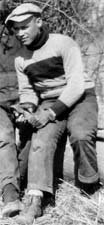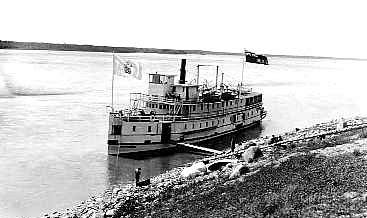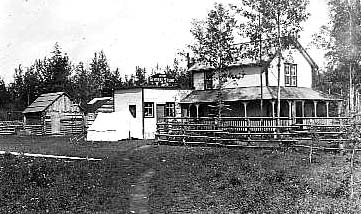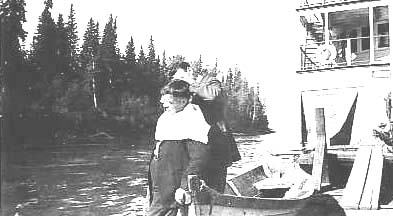 |
Drs. Willard Reddon Haig and Arthur Aitcheson Haig were born in Devil's Lake North Dakota. Willard in 1899, Arthur in 1901. They moved to Claresholm, Alberta with their family in 1902 where they lived until 1920 when they entered the University of Alberta. Before leaving for the Medical School of McGill University in Montreal the brothers worked summers aboard Hudson's Bay Company freighters in the north country. Both brothers graduated in 1926, Arthur with the Wood's gold medal. Arthur set up a medical practice in Lethbridge in 1928 and the Drs. Haig & Haig along with brother Russel as manager formed the nucleus of what became the Haig Clinic which continues to this day. Arthur was president of the Canadian Medical Association (Alberta Division) in 1957 and wrote these memoirs in the late 1960s. He passed away in 1986, Willard in 1989. |
||||||||||||||||||
 |
|||||||||||||||||||
|
Mackenzie River Adventures *** Haig & Haig |
|||||||||||||||||||
|
|
|
||||||||||||||||||
|
|
|||||||||||||||||||
| During the 1921-22 term, Willard and I began to take stock as to what summer employment might be available to us. There seemed to be few available jobs in the immediate Edmonton area, but we heard that deck-hand jobs on the Hudson's Bay Company boats in the North Country might be available to university students. It is possible that we had inherited some of that spirit of adventure that our Grandfather must have had when he joined the group from Upper New York State en route to California at the time of the gold rush. The two of us went to inquire at the Department of Northern Affairs of the Hudson's Bay Company in Edmonton. We were not encouraged in that they informed us that the wages were not good, being only $40.00 per month and keep for deck-hand labourers, and moreover, the work was strenuous. The fact that we were not definitely rejected, encouraged us to persist. We returned again in two weeks and were not given a favourable answer on this occasion either. However, on our third trip to the office we were accepted as deck-hands on the S.S. Mackenzie River, a Stern wheeler which was on what was termed the "down north run", travelling from Fort Smith, North West Territories, to the Mackenzie River Delta and up the Peel River to Fort MacPherson. We were elated with our good fortune and although Mother was not just as enthusiastic, she acquiesced to our desire in this regard... Having successfully completed our second year in our Medical course. it was with considerable anticipation and excitement that we left Edmonton for the north and we travelled along with eight or ten others who were all strangers to us, in an empty box car by way of the Alberta and Great Northern Railway en route to Fort McMurray. I well recall that our progress was slow, particularly from Lac La Biche north, because of the state of the railroad bed. As the train traversed the treacherous muskeg country, the hazard of derailment was always great. Indeed, we did meet with this situation about eight to ten miles short of our destination which necessitated that we walk this distance in a downpour of rain. We arrived very damp in most respects but not in spirits. |
|||||||||||||||||||
 |
|||||||||||||||||||
| S.S. Mackenzie River | |||||||||||||||||||
| As already stated, Willard and I were hired as deck-hands on the S.S. Mackenzie River whose route of travel was from Fort Smith, North West Territories, north along the Slave River, across the Western portion of Great Slave Lake to the post at Hay River, then across the lake to the source of the Mackenzie River, and down this huge waterway to the Arctic. After our arrival at Fort McMurray we proceeded to Waterways and we were utilized there in getting the Hudson's Bay stern wheeler steam ship stationed there, out of dry dock so that it could commence it's initial run between Waterways, down the Athabaska River, across Lake Athabaska to Fort Chipewyan and along the Slave River at it's source as far as Fort Fitzgerald near Alberta's northern boundary. Soon after leaving Waterways on our journey down north, we were impressed by the black oily-looking river banks. I have been surprised through the years that these Athabaska tar sands with their obvious rich deposit of oil, have taken so many years to be commercially utilized. Upon our arrival at Lake Athabaska, we were held up for three or four days before proceeding across the lake to Fort Chipewyan because of the presence of considerable ice there. After conditions improved so that we could make the crossing without hazard, we young men, from what the northerners called the "outside" got a great thrill as we approached the Fort in preparation for docking. Lined up on the lakeshore was a large flock of people, for the arrival of this first river boat of the season was an exciting event for the isolated northerners. This group, in their multi-coloured apparel consisted mostly of Indians and Metis with a sprinkling of white folk. A red coated Mountie or two were present, as was a priest and a nun or two in their characteristic garb. There were many children too and barking husky dogs. This sight was a forerunner of almost identical ones which we were to see during the weeks ahead at the various forts at which we were to dock along our route down to the delta of the great Mackenzie River. When one considers that our boat's arrival was the first contact with the outside that these people would have had since the preceding summer, except for the odd traveller by dog team during the winter months, one could appreciate the excitement which it's arrival would engender. Soon the exploits of the bush pilots would lessen to a considerable extent the long period of isolation for those in the northern outposts of our land. Due to rapids, river transportation on the Slave River between Fort Fitzgerald in Alberta and Fort Smith in the North West Territories was not feasible. Consequently, all the supplies for further down north had to be unloaded and transported by vehicles, while we employees of the S.S. Mackenzie River hiked the twelve to fifteen miles portage.
|
|||||||||||||||||||
 |
|||||||||||||||||||
| Connybear's Store — Fort Smith | |||||||||||||||||||
| For a period of approximately two weeks we were kept busy a mile or two down river from Fort Smith where the S.S. Mackenzie River was in winter dry dock and she had to be launched and then loaded with supplies for the numerous Hudson's Bay posts further north and gotten ship shape for the season's first trip. During this period in our leisure time, we met some of the towns people from Fort Smith and I recall particularly the Connybears, an English couple who had a store there which Mrs. Connybear, a charming lady, managed. She was particularly interested in Willard and myself as university students, because she had two teen-age children who were taking their High School subjects by correspondence courses and she hoped that they would qualify to go "outside" and attend the University of Alberta. We encouraged her and also her offspring in this regard, and it was of interest to us in later years to note that both accomplished their wish with distinction. The oldest, Mabel, graduated and eventually taught in the Department of English at the University, and the son, Kenneth, had the distinction of being awarded a Rhodes Scholarship from the University of Alberta. I cannot but wonder if our advice and encouragement in that summer of 1922, when they were at that very impressionable age, was a factor in their success. I hope that it was.
|
|||||||||||||||||||
 |
|||||||||||||||||||
| Like the hunter, who plants an artificial decoy to attract the birds. | |||||||||||||||||||
| I have already mentioned our wage stipend of $40.00 per month. At this time an opportunity arose which gave promise of possibly improving our position in this regard. The cook who had been hired for the S.S. Mackenzie River had purchased some hair clippers and scissors, hoping that he might do some barbering on the side. His attempts to function in this regard were not encouraging. He was not a very good cook either but his failures as a cook were not as open to the public view as were his tonsorial inadequacies. I offered to pay him $3.00 for his equipment and made a deal. Periodically during the rest of the summer, I increased my financial status by cutting hair. The method used to obtain paying customers was interesting. Like the hunter, who plants an artificial decoy to attract the birds, I would offer a free hair cut to a fellow deck-hand who I would posture on a chair out on the open deck. Hudson's Bay Company officials, oil company executives, officers of the RCMP, prospectors and other paying passengers on the boat if impressed with the quality of the job I was doing, and if needing a haircut, would soon appear and request one. I would make no charge but even in those days, seldom would anything cost less than $1.00 in the North Country, and so I would usually get a tip of this amount. When the season ended, I was pleased to find that I had made an additional $100.00 to supplement our finances for the coming winter.
In due course we began our journey down stream on Slave River toward Great Slave Lake. This was toward the end of June. Again ice conditions prevented our immediate passage across the lake en route to Hay River. It was July 1st before we were able to proceed. A disturbing experience occurred after we docked at the Hay River Post. There was a trained nurse associated with the Anglican Mission there, and by some means, she had been informed that medical students were aboard the S.S. Mackenzie River, so she was on the shore anxious to seek our aid in seeing a critically ill Indian boy under her care. When we informed her that we had only been exposed to premedical studies and would be of no help to her in this regard, she still insisted that I accompany her to see the lad, as the family would be disappointed if no one arrived. The little boy was in extremis with general peritonitis, undoubtedly the result of appendicitis with perforation of the organ. It is doubtful if, under the best of circumstances, he could have been saved, but it was a frustrating experience to be called in at that stage of my career when the only living organisms that I had studied was an earthworm, a bull frog and I had dissected a dead fish. After unloading supplies at Hay River, we proceeded to Fort Resolution and then crossed the lake to the source of the Mackenzie River and travelled down stream unloading supplies for the Hudson's Bay Posts at Fort Providence and Fort Simpson. At Fort Simpson, which is situated on the Mackenzie River at the junction where the Liard River flows into the Mackenzie, I was impressed by a very myopic gentleman, past middle age, named Flynn Harris who was the Indian agent. We were invited over to his home where we visited with him in his well stocked library. He was married to an Indian woman and had several very attractive daughters. His story was interesting. He had studied law at Dalhousie University, Halifax, and had been a classmate, indeed, a roommate of Sir Robert Borden in his student days. He had graduated with distinction, and after practicing law for a period, he had joined the Royal North West Mounted Police. He developed an alcoholic problem and was eventually let out of the force. He then worked for the Hudson's Bay Company for a time but again his problem caused him to be discharged. When we met him, he was employed as an Indian Agent and appeared to be free from his drinking problem but his eyesight had failed to a degree where he had to get his face within six to eight inches of a paper to read it or even to sign his official documents. At Fort Simpson one of our interesting passengers disembarked to begin his stint as assistant to the Hudson's Bay factor at that post. He was a young Scot who had signed up with the Hudson's Bay Company in Scotland. He was intensely interested in photography and I recall that he had the equipment to develop his films and he used one of the ship's cabins as a dark room. From Fort Simpson we proceeded down stream to Fort Wrigley and then on to Fort Norman. We were impressed by the fact that there was a film of oil on the river water in the vicinity of the Fort Norman post. The Imperial Oil Company, even at that date, had done considerable exploration for oil, apparently with success, but was not utilizing their oil potential fully due to the cost of transportation. |
|||||||||||||||||||
|
|
|||||||||||||||||||
| Back to part 2 - Our Mackenzie River Adventures
Back to part 3 - Our Mackenzie River Adventures |
|||||||||||||||||||